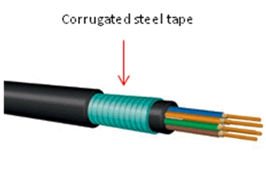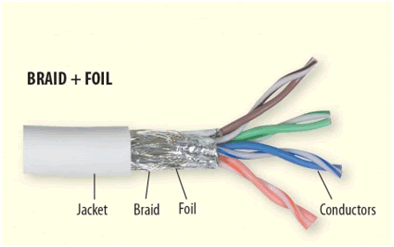Specialized Cabling Systems for Military Applications
Specialized Cabling Systems for Military Applications
When designing a communications system for a military application, several factors must be considered to address the harsh conditions often found in the field. Many commercial off-the-shelf (COTS) solutions can achieve these design goals. This Cable Focus on ruggedized cable is an excerpt from a white paper available in its entirety on L-com’s website.
Factors to Consider
Communications systems for use in combat theater operations require unique considerations compared to non-military, commercial communications systems. Many of the voice, video, and data systems used by the military are mobile and designed for rapid deployment in harsh environments where temperature extremes, shock, vibration, dust, and moisture are prevalent. The constant jostling, vibration, and even major shock experienced in combat could potentially disable a commercial datacom system. Other potential hazards encountered in military operations include heavy EMI and RFI caused by close proximity to noise-generating devices such as motors, switching power supplies, and microprocessors.
When designing a communications network for military applications, all the factors listed above must be taken into consideration. Today, specialized infrastructure products exist to address the needs of a combat-ready military communications system.
Fiber Optics
The use of fiber optic technology in military communications systems provides several benefits: First, fiber is immune to EMI and RFI noise; second, fiber can support very long distances before a repeater is necessary; third, fiber offers very large bandwidth and can be used in voice, video, and data applications; and finally, the cost of fiber continues to go down as a multitude of manufacturers, both domestic and foreign, can now produce high-quality fiber cabling, connectors, and transceivers.
Fiber Optics for Military Applications
Products now exist to address the needs of a military network design. Specialized military connectors such as the Straight Tip (ST) are offered with extra heavy tension springs to assure physical mating will not be compromised in the event of a major shock or vibration. Other variations of the fiber ST connector are available that feature a locking mechanism that prevents optical disconnects in high shock or vibration environments.
 Other militarized fiber optic connectors include Ingress Protection (IP) rated designs that feature extra robust strain reliefs and screw lock mating for solid optical connections even when subjected to shock and vibration. Typical strain relief on these connectors is well over 250 Newtons (56 lbs.), which is more than 50% better than standard, commercial fiber connector strain relief designs. This added protection ensures the cable assembly will survive incidental contact during the course of field use.
Other militarized fiber optic connectors include Ingress Protection (IP) rated designs that feature extra robust strain reliefs and screw lock mating for solid optical connections even when subjected to shock and vibration. Typical strain relief on these connectors is well over 250 Newtons (56 lbs.), which is more than 50% better than standard, commercial fiber connector strain relief designs. This added protection ensures the cable assembly will survive incidental contact during the course of field use.
Fiber cable is now also offered in military/industrial styles featuring armored (typically corrugated steel) fiber cable as well as special crush- and impact-resistant simplex and duplex fiber patch cable designs.
Copper Ethernet Cabling: Category 5e/6
Sometimes fiber optic systems cannot be used in the military communications systems due to legacy equipment or purely on purpose, whatever that reason may be. In these cases, category-rated copper infrastructure products are required.
Traditional civilian/commercial installations often use the standard unshielded twisted pair (UTP) cabling system, which is fine for the controlled environments where most times the cabling is installed and never touched again for years. In the world of military communications applications, UTP systems will not cut it. By coupling shielded twisted pair (STP) cabling and ruggedized military-style connectors, most design requirements can be met.
Shielded twisted pair cabling is used to lessen the effects of potentially data-damaging EMI and RFI by either reflecting the EMI/RFI or by picking up the interference on the shielding and then conducting it to ground. In order for this shielding to work, both shielded cable and shielded connectors must be used and the entire system must be properly grounded.

Example of double-shielded Category 5e cable
Many styles of military-grade, category-rated connectors exist today, including transversely sealed jack-and-plug options in zinc nickel, which provide an excellent level of corrosion protection, and anodized finish that also increases corrosion resistance and wear resistance. These types of military connectors feature a compression nut that establishes the cable strain relief, thus keeping the connection even when bumped or hit. Additionally, these types of connectors support 360° shielding when terminated to the cables’ shielding.
Jacket Compounds for Copper and Fiber Cabling Systems
The cable jacket compounds are another consideration when designing cabling systems for military use. Typical UTP cabling often utilizes polyvinyl chloride (PVC) material in the outer cable jacket. PVC is very toxic when burned and can act as a wick, increasing the spread of fire.
A very popular jacket type used in military cabling systems is Low Smoke Zero Halogen (LSZH). LSZH cable produces very little smoke and no halogens such as fluorine, chlorine, and bromine, which can cause harm to expensive communications equipment as well as endanger human lives. LSZH cables will self-extinguish and are used extensively in shipboard, aerospace, and mobile vehicle applications where confined space communications/networking is prevalent.
Another popular cable jacket type is polyurethane, which stands up to damaging UV rays, is resistant to oils and petroleum-based products, and is very resistant to mechanical abuse, in which abrasions and cuts are common. One downfall when using polyurethane-jacketed cables is that they give off very toxic gases when burned and do not self-extinguish like LSZH cables.
Other Types of Ruggedized Communications Solutions
In addition to fiber optic and copper RJ45-style interfaces, manufacturers are continuing to add other militarized/rugged products to address military communications systems, including USB, VGA, and D-subminiature interfaces.
When designing a communications system for a military application, several factors must be considered to address the harsh conditions often found in the field. Many commercial off-the-shelf (COTS) solutions can achieve these design goals.
- Facts & Figures: Semiconductor Market Grew to a Record $336 Billion - March 2, 2015
- TLC and Metz Ethernet Cat 6A Patch Cords in Seven Vibrant Colors - January 27, 2014
- Cables Unlimited LC-LC Duplex Ruggedized Fiber Jumpers - January 27, 2014

